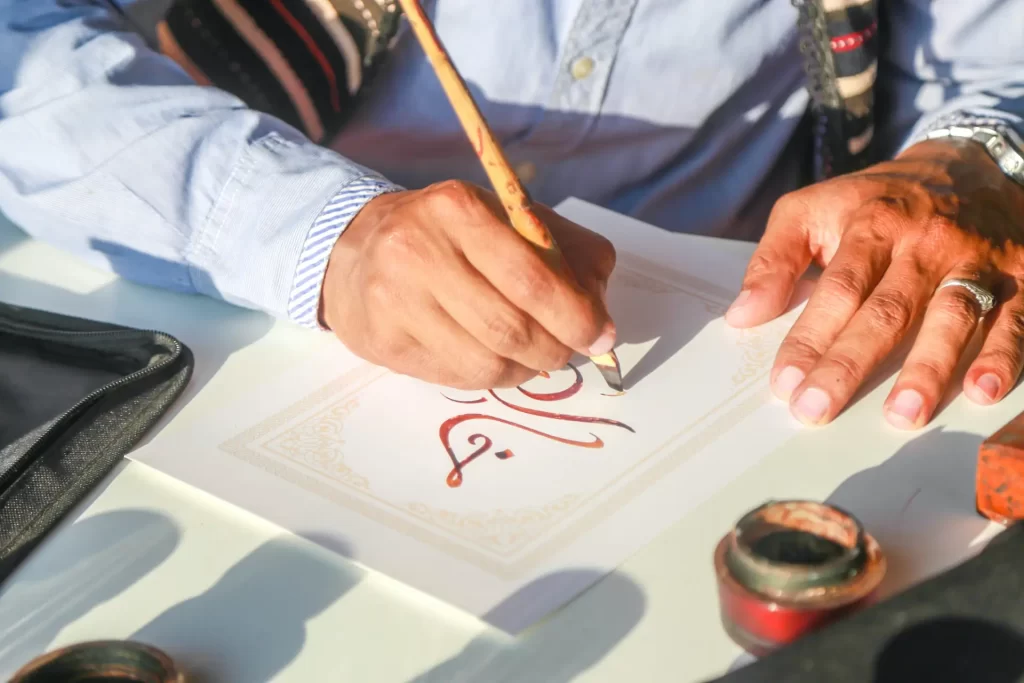Arabic Calligraphy
Unveiling the Beauty and Intricacy of Arabic Calligraphy: From Traditional to Modern Are you captivated by the aesthetic beauty and intricacy of Arabic calligraphy? In this blog post, we are excited to delve into the rich history and significance of this art, explore its various styles, and discover its modern applications. What is Arabic Calligraphy? First of all, it is an ancient art that involves the skilled writing of Arabic letters in a visually appealing manner. The letters themselves are transformed into beautiful works of art, conveying messages through their aesthetics as well as their meaning. This art is characterized by its intricate designs, fluid lines, and harmonious balance. In addition, it is used in a variety of ways, including in religious texts, poetry, and other forms of art. The History and Significance of Arabic Calligraphy It has a rich history that dates back to the 7th century, when the Arabic language was standardized and the Arabic script was developed. Earlier, it was primarily used for religious manuscripts and texts and was characterized by its geometric and angular style. Over time, it evolved into a more complex and artistic art form with different styles, including Kufic, Naskh, Thuluth, and Diwani, each with its own unique characteristics and applications. During the Abbasid Caliphate, Arabic calligraphy reached its peak. This was a time of great cultural and intellectual achievement in the Islamic world, and calligraphy flourished. Many of the most famous Arabic calligraphers lived during this time. Actually, it has played a significant role in Islamic art and culture, as it is used to transcribe the Quran and other religious texts. Also, it has been used in the production of manuscripts, ceramics, textiles, and other forms of decorative arts. After the fall of the Abbasid Caliphate, it continued to develop. It was influenced by other cultures, such as the Persian and Turkish cultures. In addition, it became more popular in Europe, where it was used for religious texts and other works of art. Styles of Arabic Calligraphy There are many different styles of this art. Some of the most popular styles include: Each style of them has its own unique characteristics. Some styles are more flowing and elegant, while others are more formal and structured. In addition to these four main styles, there are many other regional and personal styles. Each calligrapher develops their own unique style, which is influenced by their training, their environment, and their own personal preferences. The Beauty of Arabic Calligraphy Letters Calligraphy letters are not just symbols of communication, but they also have an artistic dimension. Each letter of the Arabic alphabet has its own unique form, and the way it is written can bring out its aesthetic beauty. These letters are not just written, but they are transformed into art forms, conveying messages through their aesthetics as well as their meaning. Modern Arabic Calligraphy It is a style of calligraphy that is inspired by traditional Arabic calligraphy but is also influenced by modern art movements. It often uses bold colors and abstract shapes, and it is often used in contemporary art and design. Some of the most famous modern Arabic calligraphers include Dr. Belal Mokhtar, Hassan Massoudy, Ahmed Moustafa, and Emad El-Nahar. These calligraphers have created beautiful and innovative works of art that have helped to bring this art to a new audience. Tools of Arabic Calligraphy The tools include a pen, ink, and paper. The pen is typically made of reed or bamboo, and the ink is made of black or brown dye. The paper is typically made of cotton or linen. The calligrapher uses the pen to create the letters of the Arabic alphabet. The letters are written in a variety of ways, depending on the style of calligraphy that is being used. Learning Arabic Calligraphy It can be learned by anyone who is willing to put in the time and effort. With practice, you will be able to create beautiful works. It is a rewarding art form that can be enjoyed by people of all ages. Check our Full Arabic Calligraphy course with Dr. Belal Mokhtar (Please note, to book for the Arabic Calligraphy course you need to choose the premium plan and book 15 hrs. maximum). Benefits of Learning This Art There are many benefits that include: Some Tips for Practicing Arabic Calligraphy Common Mistakes to Be Avoided When Practicing Conclusion In essence, Arabic calligraphy is a beautiful and expressive art form that has a long and rich history. It is a way to learn more about the Arabic language and culture, and it can be a relaxing and therapeutic activity that can be enjoyed by people of all ages.
Arabic Calligraphy Read More »

